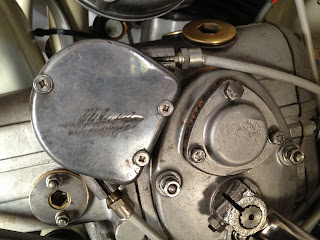I have had the exhaust silencer and tail pipe for some time. I bought it in the early days from Scooter Surgery thinking that it would only a few weeks before I would want to start the engine. How wrong can you be? Having planned so far ahead I was very disappointing to when a realised that I had not included a gasket with my order (pity no one thought to suggest I might need one). Another call to Scootopia and I had my gasket.
I had to modify my working center stand so that I could move the silencer into position. At first I thought I would check the alignment of the rear tail pipe without fitting the gasket. It proved impossible to make any assessment because even a small movement between the cylinder barrel and the silencer flange moved the end of the exhaust pipe so much. I would have to fit the gasket and tighten it up fully in its final position.
This set the next challenge. The silencer flange nut was tight when screwed onto the barrel and it was impossible to rotate it more than a couple of turns. The thread is very fine and I was concerned that there was a danger of crossing the thread on the brass nut and making it almost impossible to recover. Patrick had said that in order to prevent leaks he used a hammer and a drift to fully tighten the nut. That might be OK for the last quarter turn but not from the start. It needed a controlled approach for the first couple of turns at least.
My solution was to make a "C" spanner. The flange nut is "castleated" and by making a spanner that would engage fully with each castlation in turn I hoped to prevent damage.
 |
| Exhaust manifold "C" spanner |
 |
| Exhaust manifold castleated nut |

I welded a piece of tube to the top of the spanner so that I could insert a bar from either end. this allowed the spanner to be reversed when removing the flange nut. The access is very limited from one side.
With the the gasket in place and the flange nut fully tightened I could now assess where the rear tail pipe ended up. Before I could do that I discovered that the fixing bracket that secures the silencer box to the underside of the frame did not align with its stud.
I'm sure that the things are carefully assembled on jigs it's just that the jig didn't fit my frame. Or was it I was being paranoid? I guess I could have just forced it line up but that would have meant there was a possibility of the gasket not fitting or the silencer being damaged.
 |
| First Cut |
It took two attempts to make the fixing bracket to align with the frame stud before I was happy that there was no significant stress.
The first cut allowed me to align the hole with the stud. Now the stud would pass through the center of the hole in the bracket but it left a gap between the frame and the bracket. I guess I could have fitted a spacer but the stud was too short.
 | |||
| Second cut (nearer the silencer) |
The second cut was made nearer the silencer and the gap opened to about 2mm. This enabled the bracket to be bent up towards the frame (down in the picture). This seemed to do the trick. Having made this second adjustment I discovered that the stud was damaged and had to be replaced so I could have fitted the spacer after all.
This was quite time consuming as each check required the full assembly of the silencer. I have to say without the "C" spanner I think all this reassembly would almost certainly have damaged the manifold nut.
Now for the exhaust tail pipe.
The tail pipe is a very tight fit into the silencer. So tight in fact that it would not push in further than the end of the slots. I managed to get it in far enough such that I hoped it would provide a gas tight fit. In this position the tail pipe mounting bracket did not line up with any fixing. I could have reduced the diameter of the tail pipe and its length but that would have meant the outlet of the tail pipe aligning with the rear break leaver. |
| This is where the tail pipe fixing naturally ends up. |
Having no idea what was the normal procedure I searched the the various pictures I had and also the parts list. Not unsurprisingly it's not a subject that is widely photographed. Some of the early models appear to have no tail pipe the exhaust system ending at the silencer outlet.
I did however find a reference to a bracket in the parts list under exhaust. Here it clearly shows "item 31 - Plate fixing exhaust pipe". Whilst this is the wrong tail pipe the parts list also includes one for my configuration and this also shows the plate ghosted in the background.
 |
| Item 31 - fixing plate |
 |
| my configuration |

Finally the clamp could be tightened at the tail pipe/silencer junction. Only when I start the engine will I know if it was all worth it.
A bit long winded but I hope it will be worth it in the end. Perhaps I should just been braver and use the heavy hammer more often, but that's not my way.
















